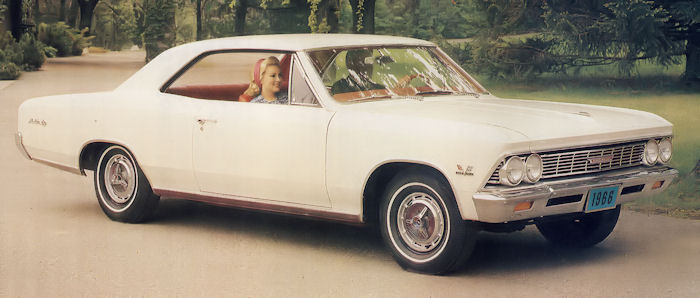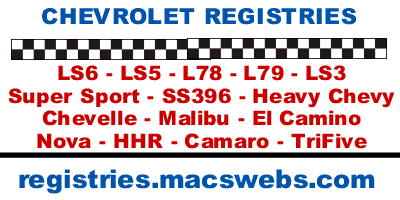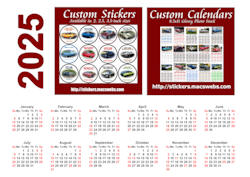Documentation Section Links
Body Broadcast Copy
Canada Line Tag
CANADIAN MALIBU SS
Chassis Broadcast Copy
Dealer Paperwork
Vintage Vehicle Services
Owner Paperwork
Trim Sheets
Window Stickers
PROTECT-O-PLATE WARRANTY CARD *
* These sections are broken down by plant and, due to the number of pages involved or duplication elsewhere, will not display this menu. You must click the Documentation menu link at the top of the page to return here.
Canadian Malibu SS


While in the United States Chevrolet was marketing the 138-series SS 396, in Canada there was a curious version that was not well known or understood; in fact its very existence is doubted by many: the Malibu SS of 1966 and 1967.
Following on the heals of the 64/65 Malibu SS where the SS was really more about trim than drivetrain, in Canada they continued with that marketing strategy. Although the 1965 Auto Pact between Canada & the U.S. would soon have marked effect on model offerings, the ’66 models were already committed to production.
In the U.S. there were a number of different series, many drivetrain combinations and many options. In Canada they made do with only 2 series, simplified drivetrain choices and fewer interior options. In the U.S. there were 300 series, 300 Deluxe series, the Malibu and the SS 396 series. In Canada there was only the 300 & Malibu series. Since there was no 300 Deluxe series for a base wagon, it was shifted into the base 300 series. Canadian production was perhaps 1/10th the U.S. in terms of volume. Sheer economics dictated a simplified lineup. For probably that reason alone, convertible production needed whatever means to get production figures up to the point where the body style was profitable to build after tooling up. Besides offering a convertible on the Malibu, there was also a 300 convertible to appeal to the traditionally thrifty Canadians. Combine that production with the Chevelle’s fraternal twin the Beaumont and it is likely that GM Canada built the cars profitably with that formula. The base 300 wasn’t a big factor on convertible sales though; for example only 96 of the V8 300-series convertibles were built for 1967! There were never more than about 200 or 300 of those cars produced annually as six cylinder or eight cylinder models.
As for the Malibu SS, it was the means by which you got bucket seats in your 135 or 136-series Malibu Sport Coupe or Convertible. In the U.S., the RPO A51 stood for Bucket Seats, but in Canada it stood for an option package referred to by GM Canada as ‘The Sports Option’. They may as well have referred to it as ‘The Malibu SS Option’ since that’s what it was, but it also turned a Beaumont Custom into a Beaumont Sport Deluxe. It even turned a Pontiac Parisienne (sort of a Catalina/Chevrolet hybrid) into a Parisienne Custom Sport.
The Malibu SS, or the 'Malibu with the Sports Option' as GM put it so clumsily in the brochures, was a trim option mainly. You bought and paid for Bucket Seats, Console (except 3-speed manual cars) and the low cost P01 Wheel Covers. Chevrolet would add the ribbed rocker panel moldings and matching rear quarter extension from the SS 396. Malibu SS emblems sourced from the 1965 models adorned the quarter panels. Front and rear it was pure Malibu, lacking any hood or grille modifications whatsoever. Out back for ’66 they simply used Argent paint fill in the Malibu rear cove to differentiate the SS. Under the conventional hood you could specify all the regular Chevelle engines; the 194, 230, 283 2-barrel, the 327 275-horse 4-barrel, PLUS you could also specify the 360-horspower Turbo-Jet 396 V8. This was a legitimate situation where a 136-series car could have a 396, whereas today it marks a U.S. car as a fake SS. Transmission choices in Canada were pretty straight forward as well; 3-speed manual, 4-speed manual (M20 only) or Powerglide automatic. The only ornamentation that showed your Malibu SS as being big-block powered were the crossed-flags on the front fenders. The 396-powered Beaumont Sport Deluxe was a true sleeper however since it used the same 'V8’ insignia that was used on 283 & 327 cars. No redline tires either for 1966.
The situation was much the same for 1967:
In the U.S. you could get a Malibu with either bench or optional bucket
seats and power ranging from a 140-horse six to a 325-horse 327 V8,
and you could get an SS 396 with either bench or bucket seats and a
396 with either 325 or optional 350-horsepower (375 horses added secretly
late in the run).
Meanwhile in Canada you could get a Malibu with bench seats and power ranging from the 140-horse six to the 275-horse 327. Or you could specify Bucket Seats on your Malibu making it a Malibu SS and get engines ranging from the 140-horse six to the 350-horse 396 V8. The ‘Sports Option’ came with buckets, console (although some have been found with column shift and no console), P01 wheel covers (now with ‘SS’ center emblems) on your dime, while GM gave the wheel opening moldings and ribbed rockers from the SS 396 to you in place of the usual Malibu fare (lower body side moldings that ran aft of the front wheel to the back bumper). The ‘Malibu SS’ emblem was again employed. The front and rear styling was regular Malibu, with no ‘Big Block’ hoods being used even with a 396, and the rear was pure Malibu. They didn’t even get any special rear end paint, Argent, black or otherwise, to distinguish a Malibu SS. Oh, I almost forgot that the wood grained dash strip was used, along with the Malibu script about the glove box. At least the horn button said ‘SS’ instead of ‘Chevelle’. For 1967 the 396-powered Malibu SS came standard with F70-14 redline tires mounted on 14x6 wheels. Also not even mentioned in the brochure but somehow ordered by a few 396 buyers anyway was the same low wide optional D96 side striping (the same one offered in the U.S. on the SS 396 optionally)
So, now you think you’re finally straight on the Malibu SS in Canada? Well they stopped with that scenario sometime in late November to mid-December 1966. Starting New Year’s 1967 the Malibu SS was gone. You could now get a 138-series SS 396 as in the U.S., and you could now also get bench or bucket seats in you Malibu and still come out with a Malibu. No more 136-series cars with 396 power, that was 138-series only.
Because the floor-shifted heavy duty 3-speed was the required 3-speed with the 396, it apparently also included the console. This revision was only noted in the revised 1966 brochure, yet curiously it was not carried forward to the 1967 Beaumont or Chevelle brochures. Due to the absolute scarcity of original Canadian-built 396 3-speed cars, combined with the omission of that detail in the 1967 brochures, it can easily be overlooked. I have contacted GM Canada Vintage Vehicle Services to try to get the actual heavy-duty 3-speed production figures in the Chevelles and Beaumonts but so far that information request has not produced any factual data. I personally would estimate that roughly only about a dozen or so cars were so equipped (unsubstantiated*).
* Note: Although the early 1966 & early 1967 brochures don’t make any reference to it, a mid-year 1966 brochure revises the package content to state: "…It includes Strato bucket seats, center console (with shift lever when four-speed, Powerglide, or 396 V8 engine is specified)…."
Cam Milne
Member #28
CanAm Chevelle Club
Reprinted courtesy of Cameron Milne.
Revised and updated on November 29, 2007
Canadian Chevelles did not have a SUPER SPORT model per se in 1966, hence all Malibu Sport Coupes and Convertibles have the 136 VIN. The SS option, A51 could be ordered with any engine much like the 1964 and 1965 U.S. SS optioned Chevelles. The L34 was the only 396 available in Canadian built cars in 1966, no 325hp or 375hp engines. Starting mid year 1967, there were Canadian 138 VIN Super Sport models being produced.
Some things to watch for on Canadian built Chevelles are the under hood, firewall, underbody and sometimes trunk were painted the body color. Some trunks were a medium gray with aqua spatter paint Two cars built a week apart may have different trunk paint schemes.
None of the Canadian-built Malibu SS models came with the scooped hood or blacked out grille like the U.S. counterpart.
My special thanks to Bill Waters for this information.
Only 50 SS 396 convertibles were built in Oshawa Ontario, making them rarer than a Z16. Of course they were the flat hood, 360 hp only. One of the fifty was owned by a fellow that was part owner of the CanAm Restoration/upholstery company in Detroit. Also in 1965, you could get the L79, 350 hp 327 in our Beaumonts and it had a name like Panther. It was a play on the Tiger since the Beaumonts were a Pontiac brand. I test drove a brand new, would you believe a white four door L79 4speed, Beaumont at Bow Mclean motors in Vancouver B.C. in 1965 and the car was awesome; ugly as sin but fast.
Information courtesy of Grant Didmon.




